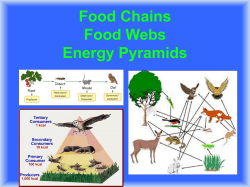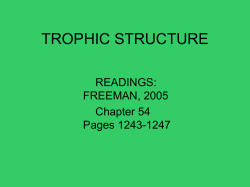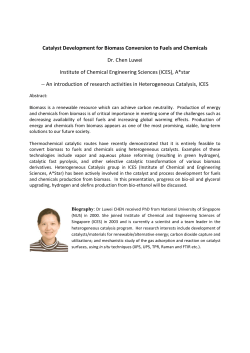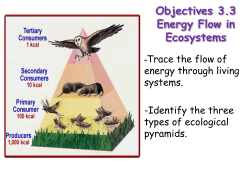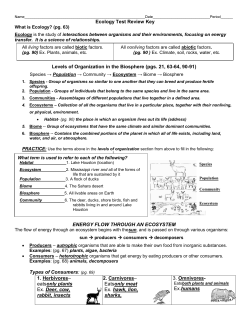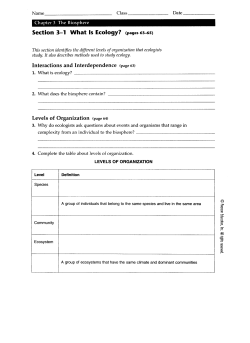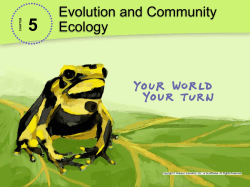
Food Webs Practice
Name: ______________________________ Date: _____________________ Independent Practice: Food Webs and Ecological Pyramids Use the terrestrial food web shown below to answer questions 1-3. 1. Which of the following lists only organisms that are secondary consumers in this food web? A Mice, rabbits, herbivorous insects, and squirrels B Predaceous insects, toads, spiders, and foxes C Spiders, foxes, owls, hawks, and snakes D Insectivorous birds, seed-eating birds, owls, and hawks 2. The terrestrial food web shown above describes many of the different food chains that are present in this ecosystem, and insectivorous birds are a part of several of these food chains. According to this food web, insectivorous birds would best be classified as – A primary, secondary and tertiary consumers B secondary consumers only C both secondary and tertiary consumers D tertiary consumers only 3. Which of the following are missing from the food web shown above? A Carnivores B Producers C Omnivores D Predators Use the food chain below to answer questions 4 and 5. Sun Grass Insect Fish Bird 4. Which organism represents the trophic level containing approximately 1% of the initial amount of chemical energy produced by the plants in this food chain? A Grass B Insect C Fish D Bird 5. If 18,500 kcal of energy is available in the grass population, around how much energy would be available to the bird community? A 1,850 kcal B 185 kcal C 18.5 kcal D 1.85 kcal Use the energy pyramid to the right to answer questions 6 and 7. 6. If 25,000 kcal of energy is available in the phytoplankton population, about how much energy is available to the river otters? A 2,500 kcal C 25 kcal B 250 kcal D 2.5 kcal 7. The diagram above shows an energy pyramid for a wetland in Mississippi. Which conclusion is supported by this diagram? A River otters are tertiary consumers and have the least energy available to them. B Crayfish are secondary consumers and have the most energy available to them. C Phytoplankton are primary producers and have the least energy available to them. D Zooplankton are secondary producers and have the most energy available to them. Use the food web to the right to answer questions 8 - 10. 8. Which of the following lists only organisms that are secondary consumers in this food web? A Mountain lion, mouse, hawk, frog B Rabbit, deer, cricket, mouse C Snake, frog, mountain lion, hawk D Hawk, mountain lion, deer, snake 9. Removing snakes from this ecosystem would cause – A an increase in the hawk population C a decrease in the mouse population B an increase in the frog population D a decrease in the mountain lion population 10. Which of the following populations from the food web shown above would be expected to have the greatest biomass? A Mountain Lion B Hawk C Grass D Mouse Use the food chain below to answer questions 11 - 13. 11. Which of the following statements about the biomass of each trophic level is accurate based on the food chain shown above? A The plant community has less biomass than the beetle population. B The dragonfly larvae population has less biomass than the mosquito larvae population. C The population of dragonfly larvae has more biomass than the plant population. D The population of beetles has more biomass than all other trophic levels. 12. Which organism represents the trophic level containing approximately 10% of the initial amount of chemical energy that was produced in this ecosystem? A Mosquito larvae B Plants B Dragonfly larvae C Beetles 13. If 10,000 kcal of energy are present in the plant population, approximately how much energy would be expected in the population of beetles? A 1,000 kcal B 100 kcal C 10 kcal D 1 kcal A marine ecosystem is represented below. Use this diagram for questions 14 - 16. 14. What is lost to the environment at each of the trophic levels of this ecosystem? A Nutrients from the soil C Food sources B Living space for the organisms D Heat 15. If the phytoplankton and seaweed community produces 50,000,000 calories, how many calories will be available for the squid population to receive? A 500 calories C 5,000 calories B 500,000 calories D 50,000 calories 16. What critically important role do decomposers play in an ecosystem? A Decomposers convert solar energy into chemical energy. B Decomposers compete with herbivores for resources. C Decomposers provide oxygen gas to other consumers. D Decomposers recycle nutrients within the ecosystem. Use the marine food chain below to answer questions 17 and 18. 17. An ocean food chain is shown in the diagram to the right. Which organism represents the trophic level containing approximately 1% of the initial amount of solar energy acquired by the phytoplankton? A Copepods C Herring B Sand eels D Humans 18. Which of the following statements about the biomass of each trophic level is accurate based on the food chain shown above? A The herring population has the greatest amount of biomass in this ecosystem. B The sand eel population has more biomass than the phytoplankton population. C The herring population has less biomass than the copepod population. D The phytoplankton community has the least amount of biomass in this ecosystem. Use the information below to answer questions 19 and 20. The Texas blind salamander (Eurycea rathbuni) lives in the Edwards Aquifer region around San Marcos. Along with other species the salamander lives in total darkness in the underground crevices and caves of the aquifer region. The table lists some of the organisms that live in this environment and their food sources. 19. In an energy pyramid for these aquifer cave dwellers, which of the following would be placed at the bottom? A Snails C Protozoa B Blind shrimp D Texas blind salamanders 20. About 10% of the energy at one trophic level is passed to the next level. What usually happens to the energy that is not passed to the next trophic level or used to carry out life processes? A It is given off as heat. C It is used in reproduction. B It is stored as vitamins. D It is used in protein synthesis. Use the information below to answer questions 21 - 23. 21. Which of the following are missing from the food web shown above? A Producers C Omnivores B Decomposers D Predators 22. Which of the following lists contains all of the organisms that can be classified as secondary consumers based on the information in this food web? A Sea Lions and killer whales B Zooplankton, baleen whales and herring C Killer whales, baleen whales, herring, and salmon D Baleen whales, herring, killer whales, sea lions and salmon 23. If killer whales are removed from this ecosystem due to the actions of humans, which of following changes would be the most likely consequence? A New predators of baleen whales would invade this ecosystem. B The population of sea lions would experience an increase in competition. C The phytoplankton community would begin to decline. D The herring population would experience a decrease in predation.
© Copyright 2025
